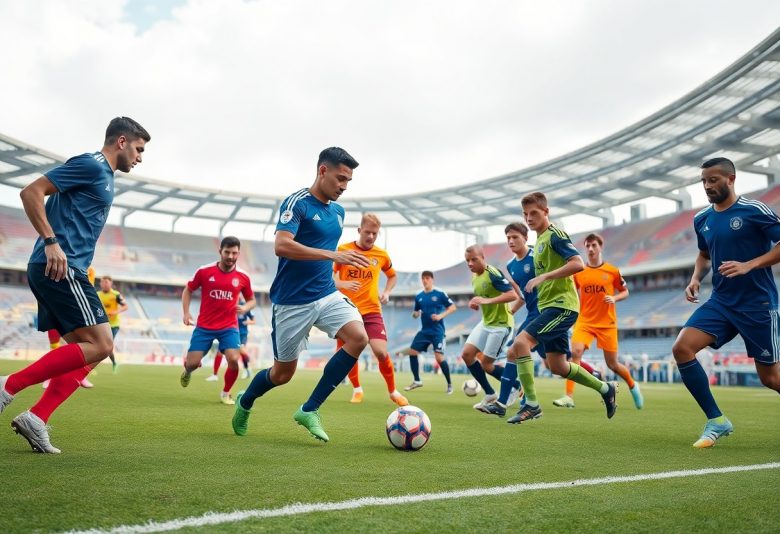Most fans are aware that football has evolved dramatically over the years, but you might not fully grasp how this transformation shapes the roles of players on the pitch today. As you explore the nuances of modern football, you’ll discover how tactics have shifted from strict formations to a more fluid style that places emphasis on individual talent and versatility. This shift not only affects player performance but also influences coaching strategies, fan engagement, and the overall dynamics of the game. Join us as we examine into how these changes impact your understanding and appreciation of football.
Evolution of Football Tactics
While the beautiful game has undergone significant changes over the decades, the evolution of football tactics stands out as a key factor shaping how the sport is played today. You will observe how strategies initially centered on formation and physicality have transformed into intricate systems emphasizing fluidity, versatility, and player intelligence. This evolution reflects a deeper understanding of the game, as tactics adapt to player skills and opponent strengths.
Historical Perspective
About a century ago, the game was primarily defined by rigid formations, such as the WM and 2-3-5, which focused on a more defensive approach. You can trace the tactical landscape through different eras, experiencing shifts driven by famous managers and tactical innovations. This historical context enriches your appreciation for the current complexity of football strategies.
Modern Tactical Trends
Besides traditions, you can see how modern football is characterized by dynamic formations like 4-3-3 and 3-5-2, prioritizing fluid, attacking play and pressing strategies. Managers today place an emphasis on adaptability, often changing tactics mid-match based on the flow of play and the opposition’s approach.
In fact, the modern tactical landscape allows for greater experimentation with formations and roles for players. You will notice that positional play focuses on maintaining spatial control and looks to create overloads in various areas of the field. Additionally, the use of advanced analytics to inform decisions has led to an evolution in training methodologies, helping players develop skills that align with specific tactical requirements. Consequently, you can appreciate how today’s footballers must possess a versatile skill set and a keen tactical understanding that aligns with their team’s playing philosophy.
The Role of Technical Skills
One significant aspect of modern football is the paramount importance of technical skills in a player’s performance. As the game evolves, your proficiency in technical abilities can make or break not just individual outcomes, but also team dynamics. Mastering these skills enables you to navigate complex scenarios on the pitch, enhance teamwork, and ultimately drive your success in this highly competitive sport.
Ball Control and Passing Accuracy
To excel in football, you must develop exceptional ball control and passing accuracy. These skills allow you to maintain possession, make precise passes, and create scoring opportunities. When you control the ball effectively, you demonstrate your technical prowess, which can influence the game’s tempo and open up new avenues for attacking play.
Importance of Versatility
Behind the scenes, the ability to adapt to various roles on the pitch is vital for modern footballers. Versatility enhances your value to the team, as you can seamlessly switch positions or take on different tactical responsibilities. This adaptability not only increases your chances of being selected but also makes you an indispensable asset in varying match contexts.
Technical versatility can help you respond to shifting game situations, ensuring that you can fulfill multiple roles as needed. By honing your skills in different positions, you give yourself the opportunity to contribute in more ways than one, elevating your overall gameplay. When you can play several roles, you become a tactical weapon, enabling coaches to utilize you effectively against different opponents, thus enhancing your career prospects and impact on the game.
Physical Conditioning and Athleticism
If you are a footballer in today’s game, your physical conditioning and athleticism play a pivotal role in your overall performance. As the sport evolves, the demands on players have increased, requiring you to maintain peak physical fitness to keep up with the pace, agility, and endurance required on the pitch. It’s no longer just about tactics; the physical aspects of the game are becoming more significant in determining your success and longevity in the sport.
Advances in Training Regimens
After years of evolution in training techniques, you can now benefit from tailored regimens that target specific areas of improvement, whether that’s strength, speed, or flexibility. Modern training is far more science-driven, integrating technology and biomechanics to analyze your performance metrics. This specialized approach helps you optimize your physical abilities while minimizing the risk of injury.
Impact of Sports Science
Training and development have been profoundly influenced by advances in sports science, leading to smarter training patterns. You’ll find that aspects such as nutrition, recovery, and injury prevention are now deeply rooted in scientific methodology designed to enhance your performance and longevity in the sport.
For instance, many clubs are now employing sports scientists and nutritionists to develop tailored programs that suit your individual needs. This support helps you understand how to fuel your body for optimal performance, recover effectively after intense matches, and maintain solid muscle health to prevent injuries. The incorporation of data analytics allows teams to monitor your workload and recovery times, ensuring you stay at the peak of your physical capabilities throughout the season.
Mental Toughness and Decision-Making
Unlike past generations, today’s footballers must excel in mental toughness and decision-making under pressure. You are not just athletes; you are strategic thinkers who make split-second choices that can change the course of a match. Your ability to maintain focus, manage stress, and adapt to evolving game situations has become just as important as your physical skills, defining your role in the modern game.
Psychological Aspects of Performance
An athlete’s mindset significantly influences performance. You must develop resilience and self-confidence, enabling you to overcome challenges and setbacks during matches. Techniques such as visualization and mindfulness can enhance your mental acuity, helping you to remain focused on your goals and make better decisions on the pitch.
The Role of Leadership on the Field
Between the tactical and physical aspects of the game lies leadership, an vital element for success. As a player, your ability to inspire and direct teammates can elevate the overall team performance. You must communicate effectively, foster teamwork, and guide others in high-pressure situations to create a cohesive unit.
Even the most talented players can struggle without strong leadership. Your role often involves being the driving force on the pitch, motivating teammates during tough moments and maintaining morale. Leadership extends beyond verbal communication; it encompasses your actions, determination, and ability to remain composed under pressure. By embodying these qualities, you contribute to building a united team that thrives on collective effort and mutual support.
The Influence of Technology
Despite the traditional image of football as a game of raw talent and instinct, technology has become a pivotal part of modern soccer. From performance analysis to fan engagement, the advancements in technology influence how teams strategize and players refine their skills. As you navigate the evolving landscape of the sport, it’s clear that embracing technological tools can significantly elevate your understanding and appreciation of the game.
Data Analytics in Player Performance
Along with evolving tactics, data analytics has revolutionized how you assess player performance. Today, coaches and analysts use vast amounts of data to track player movement, tactical positioning, and in-game decisions, providing insights that enhance training and match preparation. This analytical approach allows you to appreciate the strategic decisions that define modern football, making the game more insightful to follow.
Virtual Reality and Training Tools
Technology has also introduced innovative training tools, such as virtual reality, which is changing the way players prepare for competition. By creating immersive game-like scenarios, players can refine their decision-making abilities and enhance their tactical awareness.
For instance, you may find a striker using virtual reality to simulate various match situations where they must decide whether to shoot or pass based on defenders’ positions. This type of training sharpens mental acuity and spatial awareness, critical components for success on the pitch. Additionally, virtual reality allows you to experiment with different tactical approaches and learn from mistakes without the physical toll of traditional training. The integration of this technology is not just a trend; it’s a representation of how modern footballers are adapting to the demands of the game.
The Changing Market for Talent
After significant shifts in the football industry, the market for talent has evolved dramatically. Today’s footballers are not only judged by their on-field performances but also by their marketability and alignment with club values. As a result, teams are investing heavily in data analytics and performance metrics to identify players who can make an impact both athletically and commercially. Understanding these dynamics can empower you to appreciate how clubs navigate the increasingly complex landscape of football talent acquisition.
Scouting and Recruitment Strategies
An effective scouting strategy has become necessary in identifying talent that fits modern football demands. Clubs now leverage advanced analytics and technology to assess player potential, evaluating both technical skills and intangible qualities like resilience and adaptability. By focusing on a more holistic understanding of player performance, you gain insight into how teams compete to secure the next generation of football stars.
Player Development and Youth Academies
Against the backdrop of changing market demands, investment in player development and youth academies has soared. Clubs recognize that cultivating homegrown talent not only strengthens the squad but also enhances the club’s brand identity and loyalty among fans.
Due to the rising costs of established players, many clubs are steering their focus toward youth academies, where they can nurture talent at a fraction of the price. This trend also enables clubs to build a sustainable pipeline of skilled players who embody the team’s playing philosophy. By fostering young talent, you will see how clubs are being more deliberate in their efforts to develop players who can seamlessly integrate into their first teams, thus securing their competitive edge for the future.
Summing up
Upon reflecting, it’s clear that the evolution of modern footballers from mere tactical players to influential talents significantly shapes the game. You witness this transformation in their increased roles as leaders, trendsetters, and community figures, which enhances both their on-field performance and off-field impacts. Your understanding of these multifaceted roles is necessary for appreciating how contemporary football adapts to societal changes, amplifying the connection between players and fans while redefining the sport’s cultural significance.




